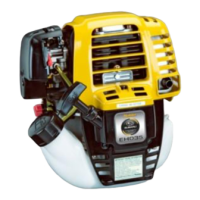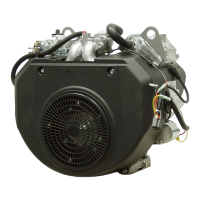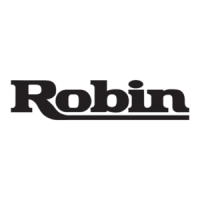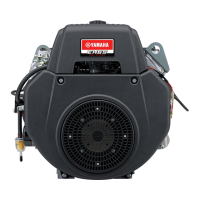Do you have a question about the Robin America EH025 and is the answer not in the manual?
Defines the engine's maximum output under specified break-in conditions.
Specifies the engine's optimal speed for longevity and fuel efficiency.
Details maximum torque and fuel consumption at peak engine output.
Graphical representation of engine performance metrics like torque and fuel consumption.
Description of the engine's cylinder block and crankcase construction.
Details the construction of the crankshaft and connecting rod.
Describes the piston material and wear resistance measures.
Explains the types and materials of the piston rings.
Details the cam gear's construction and materials.
Describes the engine's forced air-cooling system.
Explains how the engine's lubrication system operates.
Details the T.I.C. flywheel magneto ignition system.
Describes the diaphragm type carburetor and its calibration.
Explains the urethane foam air cleaner element and its function.
Explains the decompression system for easy starting.
Provides a detailed cross-section of the engine components.
Provides essential advice before disassembling or reassembling the engine.
Lists specialized tools required for the EH025 model.
Step-by-step instructions for taking the engine apart.
Step-by-step instructions for putting the engine back together.
Details the reassembly of the cylinder block, valve springs, and retainers.
Instructions for reassembling the connecting rod, piston, and piston rings.
Guidance on installing the cylinder block and crankcase.
Steps for installing the oil case and its components.
How to properly install the flywheel onto the crankshaft.
Steps for installing the ignition coil and adjusting the air gap.
Instructions for installing the blower housing.
Details on aligning and installing the cam gear.
Procedures for installing the push rod, cam lifter, and rocker arm assembly.
Steps for installing the camgear cover.
How to adjust the valve clearance to the specified tolerance.
Procedures for installing the rocker cover.
Installation of pulley, fuel tank, and recoil starter.
Instructions for installing the muffler and its gasket.
How to attach the insulator to the carburetor.
Steps for assembling the carburetor and air cleaner components.
Proper procedure for installing the spark plug.
Instructions for installing the clutch assembly.
Procedures for installing the engine cover, stop switch, and plug cover.
How to fill the engine with oil and check the oil level.
Describes the T.I.C. ignition system for the EH025.
Troubleshooting steps for magneto ignition failures.
Explains how the automatic decompression system operates.
Checks to perform on the decompression system components.
Details the operation and construction of the diaphragm carburetor.
Step-by-step guide for disassembling and reassembling the carburetor.
Safety and preparatory advice for carburetor maintenance.
Detailed steps for taking apart and putting back together the carburetor.
Guidelines for inspecting carburetor components for damage or wear.
Explanation of model and date markings on the carburetor.
Step-by-step instructions for disassembling the recoil starter.
Step-by-step instructions for reassembling the recoil starter.
Checks to perform after the recoil starter has been reassembled.
Additional guidance for recoil starter maintenance and repair.
Common issues and solutions for engine starting problems.
Problems related to the fuel system affecting engine start.
Checks for lack of compression that prevents engine start.
Checks for lack of spark or timing issues.
Causes and solutions for engine misfiring.
Reasons why the engine might stop unexpectedly.
Causes and remedies for engine overheating.
Reasons for engine knocking sounds.
Causes of engine backfiring into the carburetor.
General guidance on mounting the engine to a machine.
Importance of fresh air for engine cooling and operation.
Safety guidelines for discharging exhaust gases outdoors.
Methods of transmitting power from the engine to driven machines.
Specifications for various component clearances and their limits.
Recommended tightening torques for engine components.
Guide for selecting the appropriate engine oil based on temperature.
Routine maintenance tasks to be performed daily.
Maintenance required after the first 20 hours of operation.
Scheduled maintenance tasks every 50 hours or 10 days.
Maintenance schedule for every 100-200 hours or monthly.
Procedures for storing the engine for extended periods.
| Displacement | 24.5 cc |
|---|---|
| Starting System | Recoil starter |
| Ignition System | CDI |
| Bore x Stroke | 28 mm |
| Fuel Tank Capacity | 0.5 L |
| Fuel Mixture Ratio | 50:1 |
| Maximum Output | 0.6 kW (0.8 hp) / 7000 rpm |











